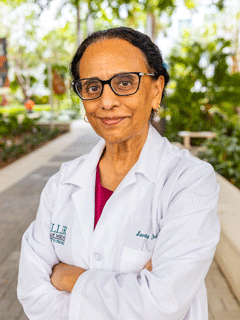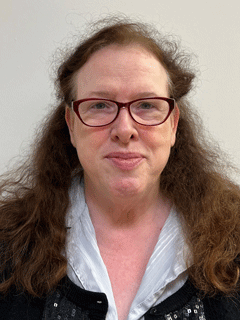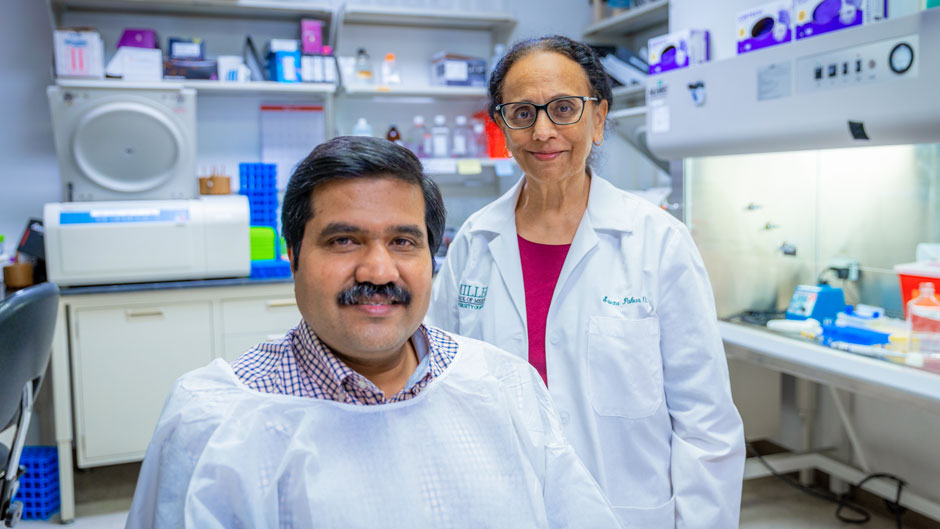Dr. Savita Pahwa can clearly recall the start of her career as a pediatric immunologist in New York City during the early 1980s.
While she had spent years training to treat allergies, cancer, and immune deficiencies, her expected path was quickly diverted. As the AIDS pandemic unfolded, Pahwa found herself tasked with caring for some of the first babies born with HIV.
It was a frightening time when doctors and medical professionals did not know how the virus was transmitted. Many of her colleagues were afraid to come close to the vulnerable, sickly children because they feared contracting the illness themselves.

But Pahwa was not only determined to help her patients, she was also intrigued by the new pathogen. She collected samples and data to help identify the virus, and soon joined a task force created by the National Institutes of Health (NIH) to find ways to combat the illness in mothers and children. Named the International Maternal Pediatric Adolescent AIDS Clinical Trial (IMPAACT) Network, Pahwa continues to work with pioneering medical colleagues at the University of Miami and across the country to develop and test drugs and treatments that help to prevent HIV transmission and mitigate the impacts of the virus.
Recently, Pahwa—who now directs the University’s Center for AIDS Research (CFAR)—and her lab were part of an IMPAACT team that accomplished a breakthrough. They were investigating whether using transplanted umbilical cord blood stem cells with a natural genetic mutation could potentially cure a patient with HIV/AIDS and cancer. And at a medical conference in February, the team unveiled their findings: a biracial patient from New York was the third person, and the first woman, to be cured from HIV just 14 months after she stopped taking her antiretroviral drugs. However, the female patient, who was being followed by a team of doctors at Weill Cornell Medicine, also had acute myeloid leukemia, which is why stem cell treatment was offered in the first place.
“This approach does not offer a widespread means of curing HIV because it’s a very restricted scenario where you have cancer and HIV, but it provides a roadmap towards a cure,” said Pahwa, who is also a professor in the Miller School of Medicine Department of Microbiology and Immunology, with appointments in the departments of Pediatrics and Medicine.
Still, the methods used in the study—in particular, the use of umbilical cord blood that naturally lacks a genetic expression of the CCR5 molecule—demonstrate an important milestone for HIV/AIDS research, Pahwa said. While two HIV-positive men with cancer have been cured of HIV through stem cell treatments in the past, those earlier methods used adult stem cells that were delivered through bone marrow transplants. Since these treatments are more challenging to match, after receiving the adult stem cell transplants, both men suffered from a complication called graft-versus-host disease. Yet, using stem cells from umbilical cord blood, the third patient did not suffer this complication, so it may offer a better path to eradicating HIV, Pahwa said.
“It’s more forgiving if you transplant umbilical cord cells than adult stem cells [found in bone marrow] because they do not have to be fully matched,” she added. “You can get by with only four of six antigens matched, and the immune system in umbilical cord cells is not fully developed to reject its new host.”

HIV/AIDS is a particularly notorious virus because it rebounds if a patient stops taking their antiretroviral drugs, even after years of using the medicine. The New York woman waited four years after receiving the stem cell transplant to stop taking her antiretroviral drugs. More than a year later, the IMPAACT team detected no HIV in the woman’s body. Then Pahwa’s lab, including research assistant professor Suresh Pallikkuth and senior research associate Margaret Roach, analyzed the patient’s blood and observed that there was no inflammation or immune activation, which are hallmarks of HIV infection. They also noted a lack of immune cells that recognize HIV.
It was a joyful revelation for Pahwa, who worked closely with lead IMPAACT investigator Dr. Yvonne Bryson of the University of California Los Angeles and other team members to fine-tune the study design.
For several years now, stem cells have been explored as a potential pathway for curing HIV because they can be purified in different ways. Then, after a person gets a stem cell transplant, their body begins making new cells with the modifications. This often helps people with leukemia, for example, to combat the grueling effects of cancer drugs and experience remission.
Over time, AIDS researchers have discovered that 1 to 2 percent of the people are born with a natural genetic mutation that results in what is called “CCR5 deficiency.” Since the HIV virus attaches to CCR5 co-receptors, in addition to CD4 molecules, to enter our body, people whose cells are CCR5 deficient have a natural resistance to HIV/AIDS. Therefore, transplanting stem cells from people (or babies) with this genetic mutation has helped cure three people with HIV.
Yet, while stem cells offer one avenue for people with cancer and HIV, explained Pahwa, AIDS researchers across the country are also exploring gene therapy, where they could reproduce cells without CCR5 for those suffering from HIV. This is one of many different approaches being tested as HIV cure strategies, she added.
“Before this study, we couldn’t figure out if the scientific data would support our idea that if you could get rid of CCR5, it could lead to AIDS remission,” Pahwa said. “Now many researchers across the country are trying to figure out if you can really cure HIV by getting rid of CCR5 through gene therapy. One day, we may be able to take a patient’s own cells and treat them, so that CCR5 is inactive.”
Pahwa expects the full findings of the IMPAACT P1107 study to be published in a few months in a major medical journal, which will further describe the process they used to help treat the New York woman.
It is not surprising that Pahwa helped develop this treatment that harnesses the power of umbilical cord blood. It has been her life’s work to treat young HIV/AIDS patients, starting with a 4-year-old girl named Tara, who died in the early days of the pandemic—before physicians had even named the virus.
She collected some of the first samples to help pinpoint HIV, and to distinguish its symptoms in children, while working as chief of allergy and immunology at North Shore University in Long Island.
Around the same time in the early 1980s, Dr. Margaret Fischl and Dr. Gwendolyn Scott at the Miller School were seeing some of the first HIV patients in Miami. Fischl and a team of University physicians helped the U.S. Centers for Disease Control recognize the virus was not limited to gay men or intravenous drug users. Soon, Scott, along with Dr. Wade Parks and Dr. Mary Jo O’Sullivan began to treat babies with HIV in Miami, and they verified that there was mother-to-child transmission of the virus. Scott and O’Sullivan later began the first clinical trials of AZT to reduce mother-to-child transmission, which later proved successful for curbing the spread of HIV. Meanwhile, Pahwa was doing her own trials of AZT on Long Island.
In 2004, Pahwa was recruited to the Miller School’s Department of Microbiology by Dr. Eckhard Podack to help spearhead its HIV/AIDS research. Pahwa earned an NIH grant in 2007 to start the University’s Center for AIDS Research. Since then, the center’s team has grown vastly. Nineteen Miller School faculty members, including co-director and professor Mario Stevenson, and Pahwa’s colleague, Pallikkuth, are part of the group.





